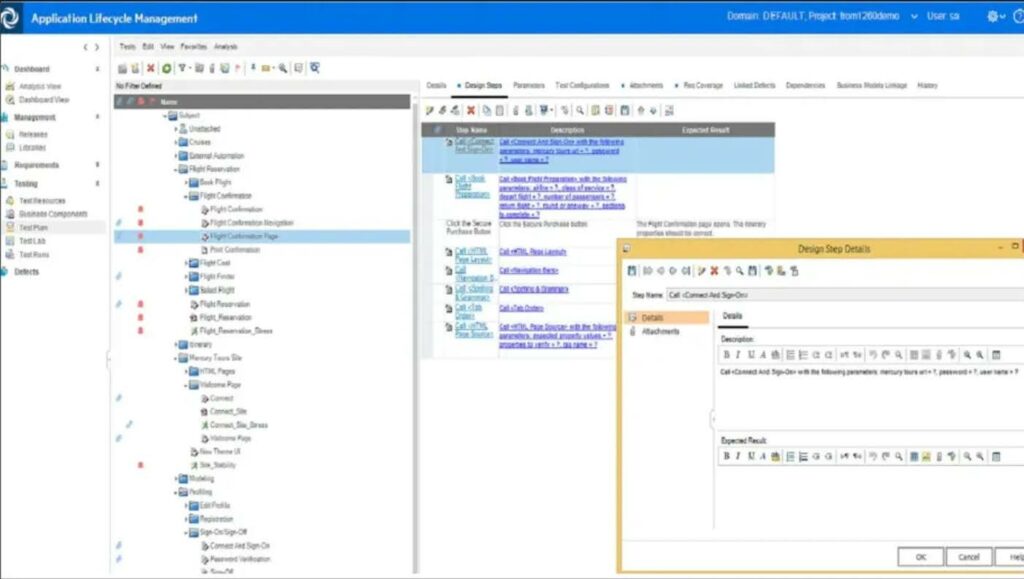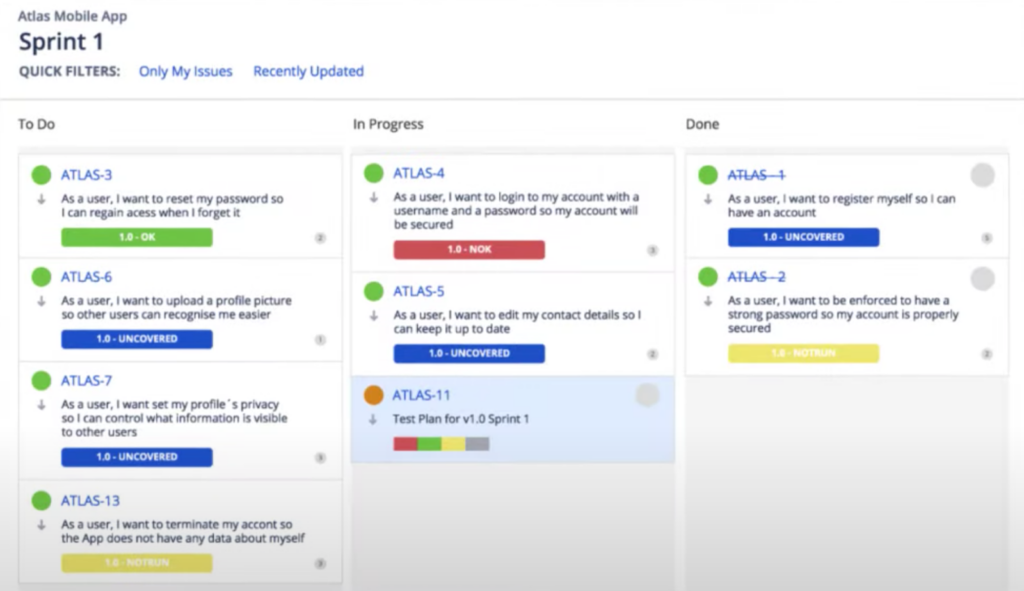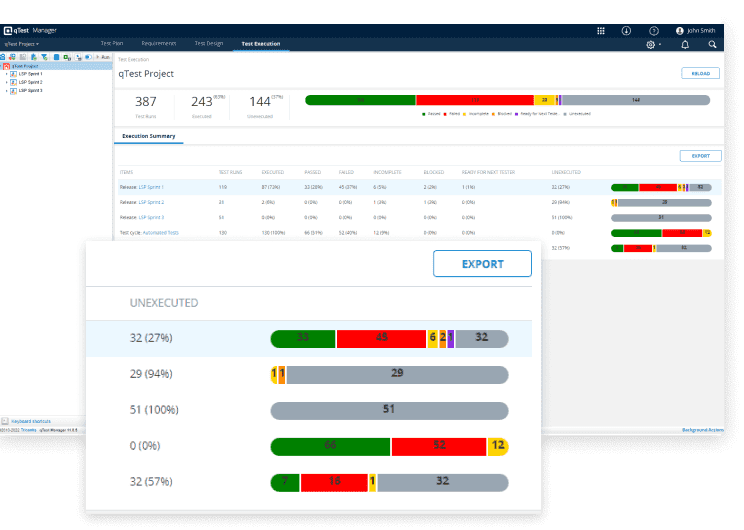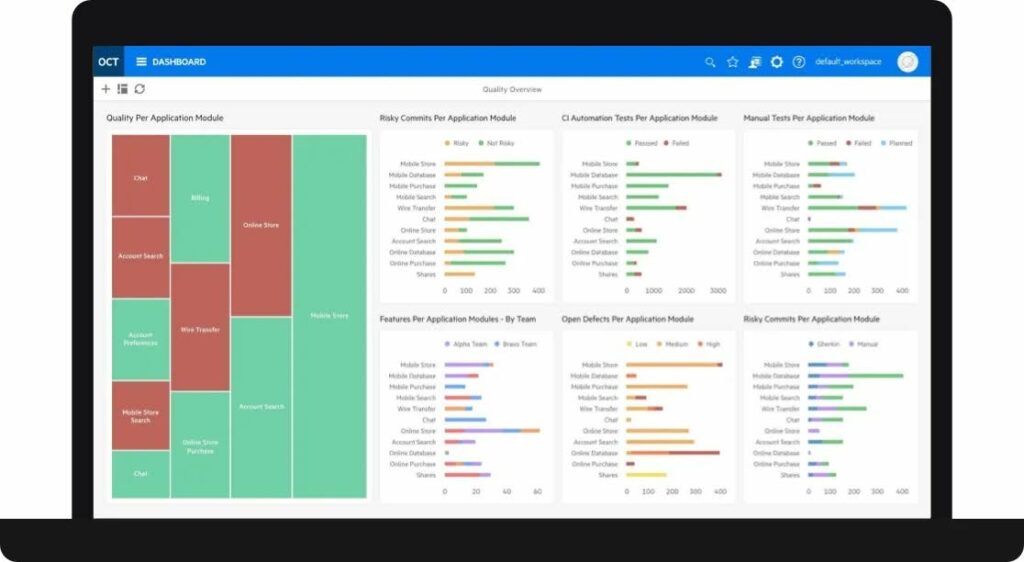If you find yourself grappling with the complexities of a legacy tool like ALM/Quality Center (also known as OpenText ALM Quality Center, HP ALM, Micro Focus ALM/QC, HP Quality Center, or HP QC) and are seeking a more streamlined, modern, and effective solution for test management, you’re in the right place.
We’ve put together a list of the top 5 ALM/Quality Center alternatives to help you make informed decisions and discover the best test management solutions for your team.
What is ALM/Quality Center?

ALM/Quality Center is a legacy enterprise software tool that facilitates end-to-end management of software development projects, from project planning and requirements gathering to testing and deployment.
Historically, many teams adopted ALM/Quality Center because it offered a number of different feature modules:
- Test Management: including test case management, test execution tracking, and traceability reporting
- Defect Management and Tracking: including defect logging, management, and tracking
- Requirements and Release Management: including the ability link test cases directly to specific requirements or user stories and oversee the release process
- Compliance Features: including auditing features, process standardization, and features designed for enterprise-scale usage.
Why consider ALM/Quality Center alternatives?
Although ALM/Quality Center provides users with a set of features and functionalities for managing the application lifecycle of software development projects, many teams have decided to move away from it for a number of reasons:
- Users report that the UI/UX is old, rigid, and clunky
- User licensing is extremely expensive
- ALM/QC requires manual traceability between test evidence and requirements
- ALM/QC doesn’t have a native integration with Jira, and doesn’t integrate easily with test automation systems or modern DevOps tools outside of the ALM system
- Users report that test case creation is so time-consuming that many users resort to an Excel add-in to write test cases
Top 5 ALM/Quality Center alternatives
1. TestRail

Image: Manage all of your manual, exploratory, and automated tests from a modern and easy-to-use web-based interface.
TestRail is not just an ALM/Quality Center alternative—it’s a centralized test management tool that gives teams total control over their testing as well as helps them test more efficiently, get real-time visibility at scale, and release high-quality software.
Compared to ALM/QC, TestRail gives you a better user experience, more flexible test management workflows, and easier integrations with modern DevOps workflows and tech stacks. TestRail is also more affordable, giving teams the ability to save costs and invest in other resources to improve their software testing program.
| TestRail | Micro Focus ALM/QC | |
| Organize test cases in folders | ✓ | ✓ |
| Store requirements and defects | 𝗫 | ✓ |
| Build traceability between requirements, tests, and defects | ✓ | ✓ |
| Dedicated test management platform | ✓ | 𝗫 |
| Accessible from all modern web browsers (Chrome, Firefox, Safari, Edge) and operating systems (Windows, macOS, Linux) | ✓ | Only compatible with IE and Edge |
| Built for Agile and DevOps testing workflows | ✓ | 𝗫 |
| User-friendly and scalable | ✓ | 𝗫 |
| Easily integrates with test automation & CI/CD tools | ✓ | 𝗫 |
| Built for enterprise | ✓ | ✓ |
| Widely-adopted industry standard | ✓ | ✓ |
| Price | $$ | $$$$$ |
TestRail key features
TestRail is a centralized test management platform that is purpose-built for testing. It comes with a number of features that can help your team orchestrate your entire QA process with ease.
| TestRail Key Features | |
| Test Case Management and Centralized Test Repository | Allows users to create, organize, and manage test cases in folder-like sections and subsections. Test cases can be categorized, prioritized, and assigned to specific team members. |
| End-to-end Traceability | Offers traceability features, enabling users to link test cases to requirements, user stories, or other related items. |
| Reporting and Metrics | Seamless native integration with Jira allows for a smooth flow of information between TestRail and Jira. |
| Security and Compliance | TestRail Enterprise meets most security requirements like SOC 2 Type 2 compliance, multi-factor authentication, and single sign-on. Organize testers in user groups, employ project-level administration (PLA), and better protect access to your data. |
| Integrations | Integrates with popular issue tracking and project management tools like Jira, GitHub, Redmine, and more. TestRail also integrates with various test automation frameworks, enabling users to combine manual testing efforts with automated tests. |
| CI/CD Integrations | Upload results from test automation workflows running in build pipelines or jobs on any CI tool. |
| Native Integration with Jira | Seamless native integration with Jira, allows for a smooth flow of information between TestRail and Jira. |
Pricing
- Professional Cloud (SaaS): Starting at $37 per month/user
- Enterprise Cloud (SaaS): Calculate pricing here
- Professional Server (On-premise): Calculate pricing here
- Enterprise Server (On-premise): Calculate pricing here
- Free Trial: Available
Customer ratings and reviews
Check out TestRail Academy to learn TestRail best practices, master product features, and train your team at scale with free multimedia courses!
2. Xray

Via Xray
Xray is a test management application designed for quality assurance in Jira, supporting both manual and automated testing processes. Integrated within Jira, Xray advocates for Native Quality Management, where all QA testing tools, tests, and processes are seamlessly incorporated into your Jira development environment.
Xray integrates with popular automation frameworks like Cucumber, Selenium, and JUnit and CI tools like Jenkins, Bamboo, and GitLab, allowing you to incorporate your automation into your CI/CD pipeline seamlessly.
With Xray, managers can optimize Agile boards by tracking requirement status and test execution progress in real time. Additionally, it ensures uniformity in naming and terminology between development and QA teams, facilitating a clear understanding of each other’s processes.
Xray key features
- Native Test Case Management for Jira: Xray provides a robust test case management system within Jira, allowing teams to create, organize, and manage test cases.
- Test Automation: Xray supports native integration into leading testing automation frameworks like Cucumber, Selenium, and JUnit.
- Xray Exploratory Testing App: Use the Xray Exploratory App to capture, record, and easily share your sessions with all team members.
- Real-Time Visibility: Xray gives development and QA teams up-to-the-moment insight into test coverage and status, all from inside user stories and agile boards.
Pricing
- Xray offers several different pricing models including Server, Data Center, and Cloud. Visit the Xray pricing page for more details.
- Free Trial: Available
Customer ratings and reviews
- Atlassian marketplace: 3.6 / 4 (397 reviews)
- G2: 4.4 out of 5 (10 reviews)
- Capterra: 4.0 out of 5 (2 reviews)
3. Zephyr Enterprise

Via Smartbear
Zephyr Enterprise is a SaaS test management solution designed to assist software development and QA teams manage their testing processes.
It provides features for creating, organizing, and managing test cases, supporting both manual and automated testing efforts. Zephyr Enterprise offers test data management functionalities, enabling teams to manage diverse test scenarios efficiently.
Zephyr Enterprise is designed for complex integrations, so organizations with multiple pipelines and platforms can bring it all together in a single view.
Zephyr Enterprise key features
- Test Data Management: Zephyr Enterprise allows teams to create and manage multiple test data sets, ensuring that different scenarios are covered during testing.
- Bi-directional and multi-instance Jira integration: This integration allows teams to manage their testing processes within Jira, providing a platform for development and testing activities.
- Global repository for test cases: Zephyr Enterprise provides a global repository for test cases that can then be shared across the organization.
- Comprehensive API Support: Zephyr Enterprise offers API support, allowing teams to extend its functionality and integrate it with other tools within their software development ecosystem.
- Robust Jira Integration: Zephyr Enterprise offers seamless integration with Jira, allowing teams to manage their testing processes within the familiar Jira environment.
Pricing
- Zephyr Enterprise offers several different pricing models including SaaS or on-premises, starting at $1,500 per user per year.
- Free Trial: Available
Customer ratings and reviews
- G2: 4.1 out of 5 (77 reviews)
- Capterra: 3.5 out of 5 (10 reviews)
4. Tricentis qTest

Via Tricentis qTest
Tricentis qTest is a test management platform designed to streamline software testing processes for agile and DevOps teams. It offers features to facilitate test case management, test execution, and defect tracking.
qTest allows teams to create, organize, and manage test cases. It supports manual and automated testing efforts and enables teams to execute tests, log results, and track defects. With its intuitive interface and collaboration features, qTest promotes efficient communication and collaboration among team members, enhancing productivity and ensuring high-quality releases.
Tricentis qTest key features
- Comprehensive Agile Support: qTest is specifically tailored for Agile and DevOps environments, providing native integrations with Agile project management tools like Jira.
- Enterprise Scalability: qTest is scalable and suitable for large enterprises with complex testing needs. It can handle large volumes of test data, users, and projects.
- Flexible Deployment Options: qTest offers flexible deployment options, allowing organizations to choose between on-premises and cloud-based solutions based on their specific security and compliance requirements.
- API and Integration Capabilities: qTest provides a robust set of APIs and integrations, allowing teams to connect it with various third-party tools and systems.
Pricing
- Tricentis qTest offers several different pricing models, starting between $1,500 – $3,000 per user per year.
- Free Trial: Available
Customer ratings and reviews
- G2: 4.2 out of 5 (57 reviews)
- Capterra: 4.4 out of 5 (23 reviews)
5. OpenText ALM Octane

Via OpenText Octane
OpenText ALM Octane is an Application Lifecycle Management (ALM) software designed to support Agile and DevOps practices, providing end-to-end visibility and collaboration across the software development lifecycle.
ALM Octane facilitates continuous integration and delivery by enabling pipeline and release management, ensuring that testing efforts align with development pipelines. Its collaborative environment enhances communication among cross-functional teams, while its flexible deployment options accommodate various IT environments, making it a comprehensive solution for organizations adopting Agile and DevOps methodologies.
OpenText Octane key features
- Built-in Pipeline and Release Management: ALM Octane includes features for managing continuous integration and delivery pipelines. It allows teams to track and manage the progress of builds, deployments, and releases.
- Seamless Integration with Micro Focus Tools: ALM Octane integrates seamlessly with other Micro Focus tools, such as Micro Focus LoadRunner for performance testing and Micro Focus UFT for automated functional testing.
- Flexible Deployment Options: ALM Octane offers flexible deployment options, allowing organizations to choose between cloud-based and on-premises solutions based on their specific security, compliance, and infrastructure requirements.
Pricing
- OpenText Octane offers several different pricing models including cloud-based and on-premises, from $490 to $2,300 per user per year.
- Free Trial: Available
Customer ratings and reviews
- G2: 4.0 out of 5 (10 reviews)
- Capterra: 4.4 out of 5 (22 reviews)
TestRail: The best ALM/Quality Center alternative for your team
The TestRail Quality OS is the only centralized QA platform that gives you the power to build, connect, and optimize all of your testing processes. Test more efficiently, get real-time visibility at scale, and build confidence in QA.

Image: Leverage a single platform to centralize your testing activities across multiple projects, teams, and locations.
The future of testing is evolving fast, and you deserve a test management solution that can scale with you. Leave outdated legacy tools behind for an enterprise-grade test management solution that seamlessly integrates with Agile and DevOps tools.
Try TestRail free today or join one of our live weekly product demos to see how you can leverage TestRail’s core functionalities to efficiently and effectively manage your software testing processes.



